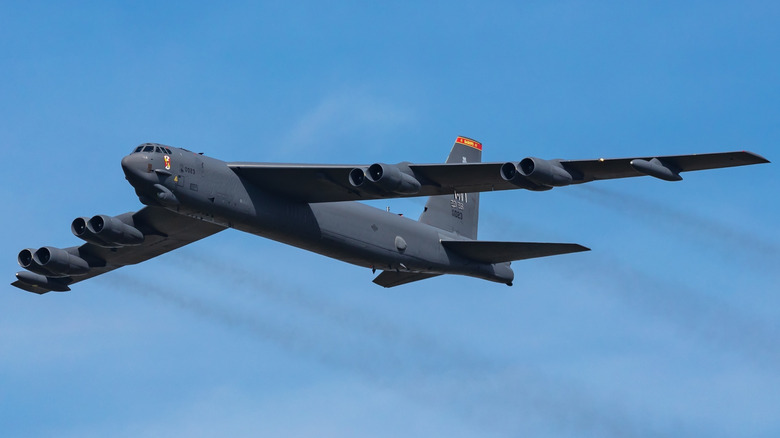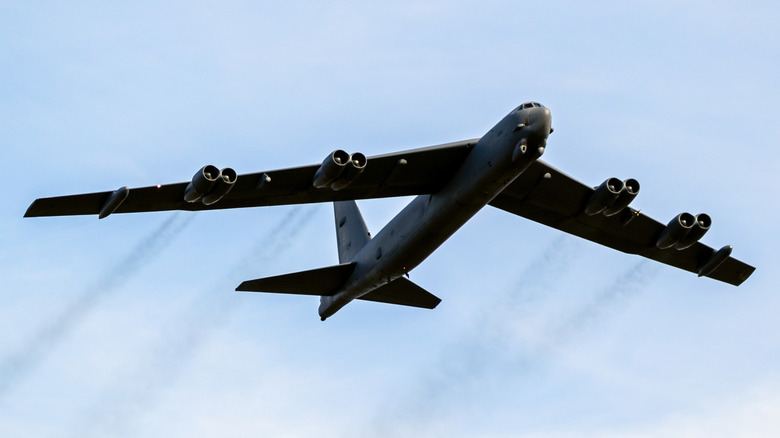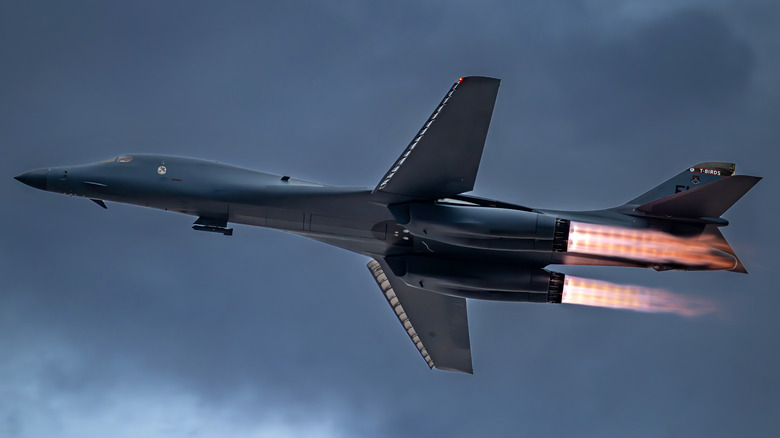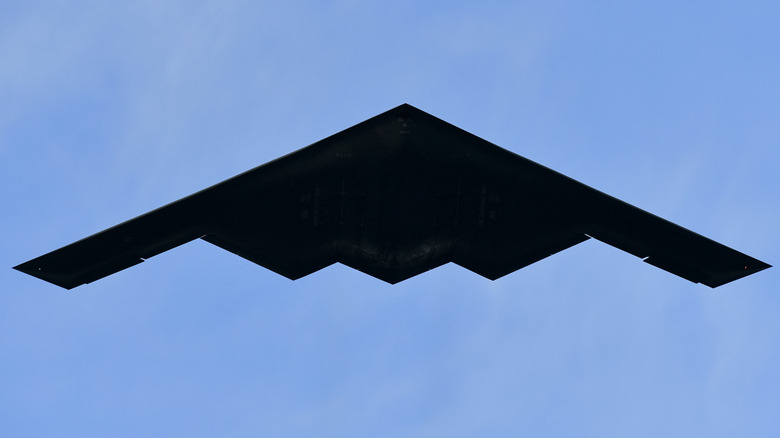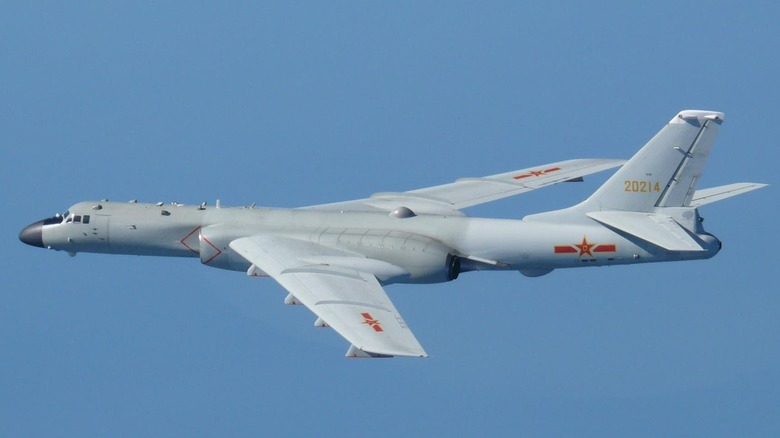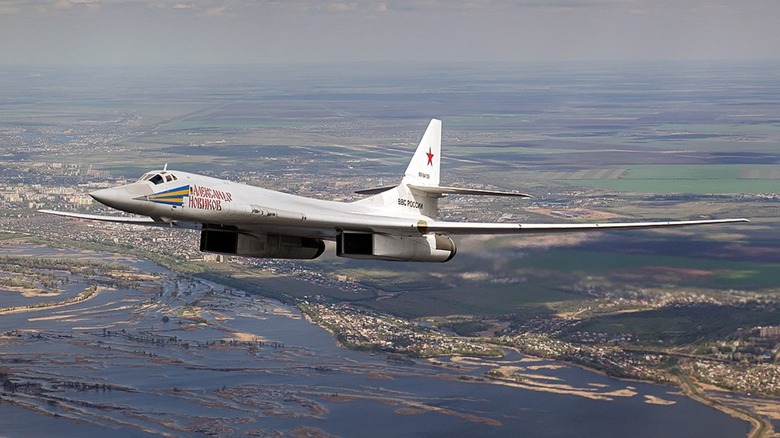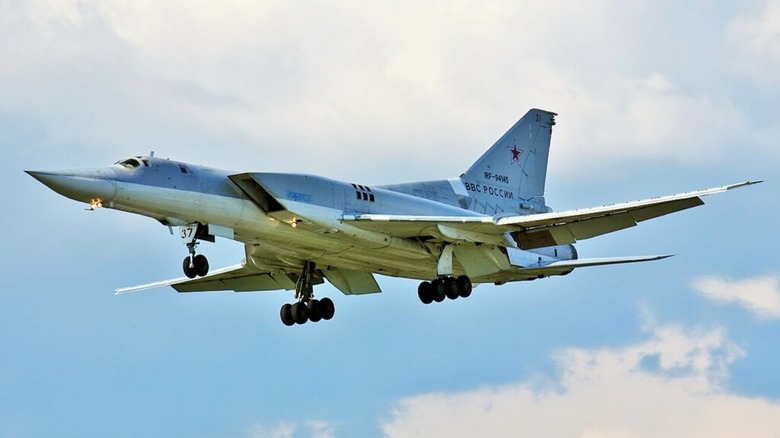Every Strategic Jet Bomber Still In-Service Today
The Wright Brothers first took flight in 1903, and a decade later, the first bomber took to the skies, a biplane that carried a dozen 10 lb. bombs. By World War II, bombers became some of the most important aircraft of the conflict, and it was a Boeing B-29 Superfortress bomber that dropped the first atomic bomb used in warfare. After the war, militaries around the world invested heavily in the development of strategic bombers designed to carry nuclear ordnance across oceans to potentially take out targets far from home.
The United States continued developing strategic bombers for decades, and that process never stopped. Soon, the U.S. will debut Northrop Grumman's B-21 Raider as the first strategic bomber developed during the 21st century, so there's a lot of time and money in keeping a fleet of strategic bombers active. While that aircraft isn't likely to enter the inventory for several years, there are a few bombers serving U.S. strategic and tactical interests in various theaters. While nuclear payloads aren't being used, conventional weapons certainly are.
These strategic bombers are an important part of the U.S. nuclear triad of strategic defense, but they are also capable of delivering conventional payloads to targets anywhere in the world. The U.S. Air Force continues to operate three different types of strategic jet bomber aircraft, some of which have been in active service for decades. Here are the three U.S. and three foreign bombers that are still in service today, though it won't be long before they're replaced by more advanced, sixth-generation aircraft like the B-21 Raider and China's new H-20 strategic stealth bomber.
B-52H Stratofortress
The B-52 Stratofortress is a long-range strategic bomber that entered the inventory in 1955, making it the oldest bomber still in service today. Of course, it's no longer using the same technology, as numerous upgrades to the aircraft have ensured the U.S. continues flying the B-52 Stratofortress long after its introduction. The bomber sports the nickname "BUFF," which stands for Big Ugly Fat Fella, though not all service members agree on the last F-word.
The B-52 has remained a key component of the U.S. Air Force's strategic bomber fleet. The modern version of the B-52 is the B-52H, which entered service in 1961. Several upgrades include installing eight Pratt & Whitney TF33-P-3/103 turbofan engines. Combined, these deliver 136,000 lbs. of thrust, enabling the aircraft to reach a maximum speed of Mach 0.84 (645 mph). The bomber can fly to a ceiling of 50,000 feet and has a payload capacity of 70,000 lbs.
Its maximum takeoff weight is 488,000 lbs. (244 tons), so it's not small. The B-52H's wingspan stretches 185 feet and is 159 feet long, with a height of just over 40 feet. The B-52H can carry a variety of ordnance, from bombs and mines to missiles and air-launched cruise missiles. Each aircraft costs $84 million (in 2012 dollars), has a crew of five, and can be refueled in the air by a KC-135 Stratotanker, making its range unlimited. The Air Force maintains 58, while the Air Force Reserve has 18 in its inventory.
B-1B Lancer
The U.S. Air Force began using the B-1 Lancer in 1985, and it was designed to fly at supersonic speeds to strike targets wherever it's needed. The bomber earned the nickname "Bone" and is an impressive aircraft with numerous capabilities. It's no wonder the Air Force is still flying the B-1 Lancer after 40+ years, as it is more than capable of delivering ordnance on targets anywhere on the planet. The modern version of the bomber is the B-1B, which features improvements on the initial design, including a reduction of its radar signature and an increase to its maximum speed.
The B-1B is powered by four General Electric F101-GE-102 turbofan engines with afterburners capable of delivering a combined 120,000 lbs. of thrust with afterburners. The bomber's maximum speed is Mach 1.2 (921 mph), but its most impressive feature is its payload capacity of 75,000 lbs., making it the largest in the U.S. inventory. The B-1B can carry a variety of ordnance, including numerous types of bombs, naval mines, cluster munitions, Joint Direct Attack Munitions (JDAM), air-to-surface standoff missiles, and more.
The bomber's wingspan reaches 137 feet, while its length is 146 feet, and its height is 34 feet. It features a variable-sweep wing design and has a maximum takeoff weight of 477,000 lbs. (238.5 tons). Each B-1B Lancer is crewed by four personnel, and the aircraft cost $317 million to produce. The Air Force maintains 62 in its inventory, though none are in the Air National Guard or Air Force Reserves, as of September 2016.
B-2 Spirit
The B-2 Spirit is one of the U.S.' most iconic aircraft, thanks to its wing-shaped design. It's the world's first stealth bomber, making it capable of flying into heavily air-defended enemy territory undetected. The B-2 entered the Air Force inventory in 1997 and has remained an active strategic bomber ever since, though only 21 were produced. This was partly due to its cost, which was immense, as each aircraft cost around $2 billion to procure.
That's not a small amount of money, but the B-2's capabilities more than make up for its cost. The aircraft is powered by four General Electric F118-GE-100 engines delivering a combined 69,200 lbs. of thrust. Its speed is classified but is believed to be in the "high subsonic" area of Mach 0.7-0.9 (537-691 mph), with an intercontinental range and an operational ceiling of 50,000 feet. Like the other strategic bombers, the B-2 can carry a variety of ordnance, from conventional bombs to nuclear weapons, in its 40,000 lb. payload capacity.
A recent test proved the B-2's ability to sink a naval ship, ensuring its usefulness in a potential future conflict with China. Each aircraft has a maximum takeoff weight of 336,500 lbs. (168.24 tons), is 69 feet long and 17 feet high with a wingspan of 172 feet. While expensive and with a relatively small payload, the B-2's strength lies in its stealth capabilities, and as of 2025, none have been lost in combat, though one crashed by accident shortly after takeoff in 2008.
Xi'an H-6
Of course, the United States isn't the only military that operates strategic bombers — both Russia and China have their own fleets built up over decades through and since the Cold War. Currently, the People's Liberation Army Air Force (PLAAF) operates one type of strategic bomber, the Xi'an H-6. This is a licensed variant of the Soviet Union's Tupolev Tu-16, which first entered service for the USSR in 1954. The Chinese began using the bomber in 1958 and manufactures its own through a license agreement with Russia.
The PLAAF has been operating the H-6 for decades, and there have been many updates and upgrades to the airframe and its systems. The modern version flown by the PLAAF is the H-6N, which is designated as a nuclear bomber. The fuselage was reshaped to accommodate air-launched ballistic missiles as well as anti-ship ballistic missiles. It can also carry and launch cruise missiles, so it's less of a bomber and more of an air-launch missile platform that likely entered service in the 2010s.
Other variants of the H-6 include the H-6M, which is designated as a cruise missile carrier, and the HD-6, which is an electronic warfare aircraft equipped with electronic countermeasures. Some variants are capable of aerial refueling, but not all of them. In terms of size, the H-6 measures 114 feet long with a wingspan of 108 feet. It's believed to be able to carry over 102,000 lbs. In ordnance and fuel, though its precise capabilities aren't known outside of China.
Tupolev Tu-160
The Soviet Union developed the Tupolev Tu-160, which first entered service in 1987, shortly before the fall of the USSR. The Russian Federation continues to operate the Tu-160, which is a nuclear-capable heavy strategic bomber featuring a variable-sweep wing design. It is operated by the Long Range Aviation branch of Russia's Aerospace Forces, which flies a modern upgrade that significantly increased the aircraft's capabilities for 21st-century combat.
The modern variants of the Tu-160 are the Tu-160M and the Tu-160M2, which entered service in the 2020s. This new variant features a whole mess of upgrades to older models, including improved avionics, a fully digital glass cockpit, updated electronics, an improved communications system, and more. It also features more powerful engines, extending its range. The new 02 Series engines add 600 miles to the bomber's range, extending it to a theoretical maximum of 11,785 miles. In terms of ordnance, the Tu-160M2 can carry both conventional and nuclear weapons, including long-range missiles.
The bomber's internal bomb bay can carry an additional 40 tons of bombs, and it has a maximum takeoff weight of 606,271 lbs. It's a beast of an aircraft, and it holds 44 world records for its size, speed, endurance, and other key factors that make Russia's primary strategic bomber a serious contender on the world stage. In addition to Russia, the Ukrainian Air Force inherited 19 older Tu-160s when the Soviet Union fell. Unfortunately, they were all traded to Russia or scrapped over the years.
Tupolev Tu-22M
The Tupolev Tu-22M is another Soviet-era supersonic long-range strategic bomber inherited by the Russian Federation that remains in service long after its introduction. The first Tu-22 took to the skies for the Soviet Air Forces in the 1970s, using it primarily for carrying missiles and bombs. Modernization efforts kicked off in the 1990s, but these faltered until the 2000s when updates were made to bring the aircraft into the 21st century, though few remained in operation or combat-capable at that point.
Russia began flying them in combat operations in Syria and in the contested skies of Ukraine during its so-called "Special Military Operation," when it illegally invaded the sovereign nation. Ukraine's intelligence chief found that Russia operated 27 Tu-22M3s, an older variant, and used them to strike the country in 2023. The Tu-22M features a variable-sweep wing design, and the latest variant, the Tu-22M3M, first took flight in December 2018.
The Tu-22M measures 132 feet in length and has a wingspan of 113 feet. It's powered by two 245.2 KN Kuznetsov NK-25 after-burning turbofan engines and is believed capable of reaching Mach 2.0 (1,535 mph) with a range of 5,006 miles. It's not a terrible bomber, but it's outcompeted by more advanced aircraft, and Russia lost one in the skies of Ukraine, marking a significant victory for Ukraine's anti-aircraft assets in the ongoing war. That suggests that the bomber could do with a stealth capability it will never receive from the Russian Federation.
